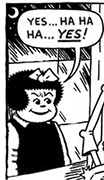|
I never played Shadowrun, but I kinda got the impression that that was its entire thing - the street samurais and whatnot deal with the physical security and heavy lifting, the hacker finds a safe place and goes into the Matrix, the mages go to the Astral Plane. So not really a style that lends itself well to 4E's central assumption that a group sticks together in a dangerous place.
|
|
|
|

|
| # ? May 23, 2024 12:18 |
|
Ghost Leviathan posted:Also, of course, social engineering, ie posing as a teenage girl who is inexplicably interested in the company middle manager and even more inexplicably interested in his passwords. A technique for modeling the vulnerability of computer systems is to make a little map (a Directed Acyclic Graph to be specific) of all the different ways to get into a system, broken into components with multiple vulnerabilities (the 'password' one had both stealing the password file and cracking it, and compromising the person who knows the password as options in an example) and how to attack those vulnerabilities. Taking one of those maps and just writing the different skill names next to each vulnerability basically gives you a computer network that can be attacked from multiple angles, including slinky dress cryptography, and even approaches that require multiple competencies. (Though, naturally, this makes the issue of the people sitting on their thumbs while the hackers hack somewhat worse, if you don't have an approach for every player.) gradenko_2000 posted:agreed. the issue isn't the hacking per se, it's the game taking a break for 3/4ths of the party A lot of games about cooking and vector calculus make it surprisingly easy to not play a mathematician-chef. It's very poor design.
|
|
|
|
The way blades in the dark does it's flashbacks seems the spot on way to do hacking, or giving the player a pool of points ala the pc game Invisible Inc, to counter security stuff.
|
|
|
|
Splicer posted:The oldest use of narrative points I'm aware of is Savage World's bennies (Deadlands might be first?), but to my knowledge getting them is generally based on good die rolls. The various WH40K games tend to give you "Don't die" points to uh not due, I think you can use them for other stuff to. Not too familiar with either system. Deadlands gives you chips for roleplay that you can spend on extra dice or XP, which is not a great way to handle it. Several pages late to the game, but a few bits. The first game I know of to have a fate point style system was the Ghostbusters RPG from West End Games in '86. They were kind of primitive (you had to spend them before you made your roll, and in the first edition you lost them if you were injured), but they were remarkably forward-looking as a mechanic. Bennies in Savage Worlds are a rework of the Fate Chips from Deadlands, which Savage Worlds is based on. And you don't get them for good die rolls, at least in SW. Everyone starts with three by default, and you get more in play for good roleplaying (especially where your hindrances are involved), advancing the plot, or just doing something cool or funny at the table.
|
|
|
|
JackMann posted:Several pages late to the game, but a few bits. Victory Games' James Bond: Roleplaying in Her Majesty's Secret Service from 1983 has a system of Hero points specifically for emulating the kind of ridiculous luck James Bond has in the movies. (Really, James Bond is an amazing achievement in genre emulation and genuinely innovative design. There are things in that game that are still revolutionary.)
|
|
|
|
LatwPIAT posted:Victory Games' James Bond: Roleplaying in Her Majesty's Secret Service from 1983 has a system of Hero points specifically for emulating the kind of ridiculous luck James Bond has in the movies. (Really, James Bond is an amazing achievement in genre emulation and genuinely innovative design. There are things in that game that are still revolutionary.) Edit: Also the first "Fate Point" metacurrency was in the 1980 Top Secret RPG from TSR, which had (as an optional rules) the ability to spend Fame Points (earned by gaining levels) and Fortune Points (earned by the GM rolling a D10 when you created a character and not telling you what the result was) to turn fatal injuries into near-misses. TS was a hot mess of a game (I swear the skill listing was copied from the department listing of a nearby community college) but it did have a lot of important "firsts" in RPG design. FMguru fucked around with this message at 08:10 on Aug 8, 2018 |
|
|
|
I've been invited to play in a Numenera game. What should I expect.
|
|
|
|
Sion posted:I've been invited to play in a Numenera game. What should I expect. A mechanic mess and a kitchen sink setting
|
|
|
|
Mojo Jojo posted:A mechanic mess and a kitchen sink setting I'm looking at the mechanical stuff and it seems okay? The GM intrusion thing seems like it could either be real cool or real bad depending on the GM.
|
|
|
|
Here's an unfinished F&F on Numenera: http://projects.inklesspen.com/fatal-and-friends/tulul/numenera/
|
|
|
|
Sion posted:I'm looking at the mechanical stuff and it seems okay? The GM intrusion thing seems like it could either be real cool or real bad depending on the GM. Feats of strength and HP draw from the same power pool. Take a further mental dive into the system implications of that and you'll start to figure out some of the issues. To the point that the video game version realised they needed to separate HP out from the stats.
|
|
|
|
i would love to run a fantasy cyberpunk campaign set in the bright republic from godbound
|
|
|
|
Serf posted:i would love to run a fantasy cyberpunk campaign set in the bright republic from godbound Same. If I can ever herd enough of my players to have a schedule on the same night for chargen.
|
|
|
|
Sion posted:I'm looking at the mechanical stuff and it seems okay? The GM intrusion thing seems like it could either be real cool or real bad depending on the GM. They're a bad execution of Fate Points. You also have to spend points out of your three HP pools to do better at relevant rolls. The three classes are just bland wizard, fighter, and guy who takes both wizard and fighter skills. The updated pseudo edition 2 gave the third class some unique abilities at least. It's a game that emphasizes that you don't get XP from beating encounters and then gives the fighter class almost no out-of-combat abilities. Damage is also greatly biased towards the Might and Speed HP pools, which the fighter class is way more dependent on. Almost nothing targets the Intellect pool that the wizard will be using more. The wizard's not-spells rapidly outpace the fighter abilities in scope and narrative weight. Overall it's just a simplified 3e D&D in a lot of ways. Functional, but the wizard wins.
|
|
|
|
unseenlibrarian posted:Same. If I can ever herd enough of my players to have a schedule on the same night for chargen. i'm currently running Blades in the Dark and Stars Without Number, but my next campaign will probably be Godbound. i might use the mortal heroes rules instead of full godbound though
|
|
|
|
Sion posted:I'm looking at the mechanical stuff and it seems okay? The GM intrusion thing seems like it could either be real cool or real bad depending on the GM. it's a Monte Cook game, so play the Wizard
|
|
|
|
gradenko_2000 posted:it's a Monte Cook game, so play the Wizard
|
|
|
|
Serf posted:i'm currently running Blades in the Dark and Stars Without Number, but my next campaign will probably be Godbound. i might use the mortal heroes rules instead of full godbound though I had a question regarding how you run SWN actually! In the default setup, combat is leaning toward a rocket tag like world where even generic enemies can be extremely deadly and (particularly at low levels), can one shot party members. Did you give any extra HP or provisions for the PCs to mitigate the extremes of such combat deadliness (maybe even Hero Mode), or did you just just roll with it? Also when it came to Blades in the Dark, did you run it in its default setting or did you make your own? Oddly enough of the couple of podcasts I've witnessed, they used their own city as a basis for the game ,compared to the far more grim default!
|
|
|
|
SkySteak posted:I had a question regarding how you run SWN actually! In the default setup, combat is leaning toward a rocket tag like world where even generic enemies can be extremely deadly and (particularly at low levels), can one shot party members. Did you give any extra HP or provisions for the PCs to mitigate the extremes of such combat deadliness (maybe even Hero Mode), or did you just just roll with it? we're two sessions in on SWN and haven't had any actual combat yet, mostly for the reasons you described. i basically warned the players of how dangerous the combat is in the game, and then we played things pretty realistically with them avoiding getting right into danger and mostly acting on the periphery of the main problem (a planet ruled by psions and an apparent guerilla movement against them) for profit. i think that the best course of action is to just be straight up about the dangers of combat at early levels and play to the game's assumption that players will mostly try to avoid a straight-up fight if they can. there's a supplement for SWN 1e called Starvation Cheap about military campaigns and Crawford even says that the PCs will be playing special forces who are going to do their best to avoid firefights and if they have to engage, do so on uneven terms with hopefully a serious advantage. if they do want to fight, remind them about the cover rules, which should be used by both sides as much as possible, and they just gotta know that melee is gonna have a hard time competing with ranged. although no matter what Warriors will be king poo poo of the fight because they get the best tools for it, limited though they may be. it also helps to maybe start them on a lower-TL planet where they will have a tech advantage (though at level 1 just about anything is dangerous as poo poo) and once they start getting things like power armor and artifact gear they will be significantly better in a fight. as for Blades, I'm running it in Doskvol, though with some aftermarket modifications to make it a bit more modern. more trains, electricity, guns etc.
|
|
|
|
Serf posted:-Stars Stuff- Yeah when considering encounters, I found straight combat just being far more deadly, in a way that really incentives ambushing and being in favorable conditions overall. One could say that about most RPGs with combat but I think the highly lethal nature of the game really pushes such planning to the forefront in a way that say, D&D can get away without doing as much. I considered Hero mode but that seems best for an extremely small group and I feel that having four characters in such a setup would trivialize the game. I do feel like adding a flat HP bonus would be help take the edge of the lethality a little while keeping the spirit of it intact. Did ever do Traveler by any chance? I found that while there are some major differences between it and SWN, they seem to broadly occupy the same niche. Both have been quite alluring systems and I would be curious to hear what you have to say on Traveler if you've ever touched it! Also yeah thank you for the info on [i[Blades[/i]  I made sure to ask here as I even recall some people here trying different setting, finding the default one a little too glum. I made sure to ask here as I even recall some people here trying different setting, finding the default one a little too glum.
|
|
|
|
SkySteak posted:Did ever do Traveler by any chance? I found that while there are some major differences between it and SWN, they seem to broadly occupy the same niche. Both have been quite alluring systems and I would be curious to hear what you have to say on Traveler if you've ever touched it! This is completely intentional, as Stars Without Number was originally designed to be "Traveller, but with a d20" (sans perhaps the lifepath character generation)
|
|
|
|
SkySteak posted:Yeah when considering encounters, I found straight combat just being far more deadly, in a way that really incentives ambushing and being in favorable conditions overall. One could say that about most RPGs with combat but I think the highly lethal nature of the game really pushes such planning to the forefront in a way that say, D&D can get away without doing as much. I considered Hero mode but that seems best for an extremely small group and I feel that having four characters in such a setup would trivialize the game. I do feel like adding a flat HP bonus would be help take the edge of the lethality a little while keeping the spirit of it intact. i think a good buff would be to let them add their Constitution score to their starting HP. that's a decent increase while not being too overpowered. i'm also working on adapting something that Crawford posted here https://plus.google.com/u/0/+KevinCrawford/posts/XEhyXFCxBRW into a system for SWN that would use the Guard mechanic to make things a lot more cinematic. the basic idea is that you have a low amount of HP that heals very slowly, but have a Guard score that acts as ablative luck or fortune and is restored after every fight. i have never actually played Traveler, but i've read it and i can definitely see the DNA carried through into SWN. and i don't really portray Doskvol as a gloomy place. its dark and grimy and haunted by ghosts, but there's plenty of room for action and adventure in there too gradenko_2000 posted:This is completely intentional, as Stars Without Number was originally designed to be "Traveller, but with a d20" (sans perhaps the lifepath character generation) he did wind up making a lifepath system for 1e in this supplement. and the skill system in revised is kinda a super-streamline lifepath system if you squint real hard
|
|
|
|
LatwPIAT posted:A technique for modeling the vulnerability of computer systems is to make a little map (a Directed Acyclic Graph to be specific) of all the different ways to get into a system, Why a DAG? Most computer systems would produce cycles if mapped this way, I think, given how common it is for trust to be transitive.
|
|
|
|
gradenko_2000 posted:it's a Monte Cook game, so play the Wizard I picked a Quick Gravity Controlling Jack
|
|
|
|
Sion posted:I picked a Quick Gravity Controlling Jack You should see a doctor about that.
|
|
|
|
Stephen Colbert and Joe Manganiello geeked out about D&D for like ten straight minutes on-air. It's pretty great, and I have serious basement envy. https://news.avclub.com/on-the-late-show-joe-manganiello-and-stephen-colbert-g-1828185507
|
|
|
|
Serf posted:-More SWN stuff- The Guard system sounds absolutely perfect for what I would be looking for, actually. I would be curious on the progress you make in placing it within a SWN context because a combination of having some ablative armour to ward of one shots, but still keeping combat a dangerous concept is a lovely combination! Having someone shot once and brought down instantly not only can cause fights to spiral, but also just isn't much fun to be on the receiving end of! Also yeah I heard that Doskvol as a default gets a bit [i]too[i] dark and gloomy, so I can understand lightening it if just a little.
|
|
|
|
Subjunctive posted:Why a DAG? Most computer systems would produce cycles if mapped this way, I think, given how common it is for trust to be transitive. The article I read used DAGs and I think it has to do with how you can model an attack as following one of many paths towards the top node. The example used by Weiss when he proposed using DAGs for computer security modeling[1] was this:  You can see how easily you can start assigning skills or scenes to each of these. "Obtain Password File" is pure Hacking, "Encounter Guessable Password" is Cryptography with a bit of Luck, "Break Into Computer Center" is a little stealth mission, "Access System Console" is some very simple Hacking, "Corrupt Sys. Admin." is a Slinky Dress or Rubber Hose approach, etc... Would be quite good for games where you play a team with different competencies, who may choose to attack a problem from different angles or try a different approach if one fails. Here's an example using individual machines[2]:   This is definitely in the "everyone else sits on their thumbs while the hacker rolls a bunch of dice"-territory if used in an RPG. The article also proposes modelling this as a solid state machine. Here's an even more specific example with trust and exploits[3]. The numbers in parenthesis denote what the trust is at that point in the chain, with 1 and 2 being the attackers and 0 being the target:  In an RPG this is definitely only for computer security aficionados. 1: Jonathan D. Weiss. A system security engineering process. In 14th Nat. Comp. Sec. Conf., pages 572–581, 1991 2: Comparing Electronic Battlefields: Using Mean Time-to-Compromise as a Comparative Security Metric 3: Towards Measuring Network Security Using Attack Graphs
|
|
|
|
That’s more or less how shadowrun 5es hacking is intended to work
|
|
|
|
This is very nostalgic for me, because I was doing network security when ftp_rhosts and friends were in fashion.
|
|
|
|
LatwPIAT posted:The article I read used DAGs and I think it has to do with how you can model an attack as following one of many paths towards the top node. The example used by Weiss when he proposed using DAGs for computer security modeling[1] was this: Visually that reminds me of the way that GURPS Cyberpunk represented hacking. It's not something I ever got a chance to actually use in a game, but the diagramming stuck with me. I've not actually read any other cyberpunk game books - is this usually how it is mapped out?  Reading through the rules though it's handled a bit differently. 
|
|
|
|
Glorified Scrivener posted:Visually that reminds me of the way that GURPS Cyberpunk represented hacking. It's not something I ever got a chance to actually use in a game, but the diagramming stuck with me. I've not actually read any other cyberpunk game books - is this usually how it is mapped out? The first figure is an attack tree, where each branch is a way to get to the target. You could draw one for any situation: a door in a medieval dungeon has a top-level node called "pass through" with approaches like "open door" (which has child-nodes like "pick lock", "steal key", etc.) and "remove door" (children include bashing it down, casting Disintegrate, etc.) The second figure is a network map, which is closer to what GURPS Cyberpunk does. The network map approach is also used by Millennium's End. I'm guessing it's used in a bunch of other RPGs too, but I'm not up to speed on every cyberpunk game or game with hacking rules.
|
|
|
|
My Lovely Horse posted:I never played Shadowrun, but I kinda got the impression that that was its entire thing - the street samurais and whatnot deal with the physical security and heavy lifting, the hacker finds a safe place and goes into the Matrix, the mages go to the Astral Plane. So not really a style that lends itself well to 4E's central assumption that a group sticks together in a dangerous place. It depends a lot on how you play it and how wedded to the original ideas of Shadowrun you are. Astral stuff isn't a big deal other than not really mapping well to grid combat, but it's quite uncommon for it to happen alongside physical stuff. Astral projection is primarily a scouting/legwork tool, with astral perception (being both astral and physical simultaneously) used more commonly once things get started. The main problem is that anything purely astral would not interact with anything physical, which is a problem with 4e's heavy battlefield control theme, especially regarding spirits which can exit the physical realm fairly easily. This could be solved mainly by limiting how astral forms can become physical. For instance, if spirits can move freely in the astral but can only manifest at specific physical locations (adjacent to their summoner for instance, or adjacent to their binding rune or what have you). There's little risk of this being a problem with mages since full astral projection is generally not where you want to be during a mission. Hacking is a bit more of a bugbear, but that's mainly because shadowrun presupposes the Matrix as a parallel combat environment which must be battled through in order to achieve your goal. now, obviously you could make the matrix it's own grid, with it's own rules for movement, it's own systems of battlefield control (i.e. you must get from the I/O site where you manifest to the node for the server, between you and it are monsters representing IC). But this loses the teamwork element, since you're dealing with one (or rarely two) hackers completely separate from the rest of the team. Probably the best way to handle that is keep hacking rooted in meatspace, outside of combat it can be handled to do things like open doors or disabling security systems just like a rogue would. In combat it can be done as a hybrid controller/leader with something like your deck's wireless range serving as an "aura" where you can buff your allies and penalize your enemies. The biggest problem is that it's thematically limited...it's fine to abstract your decker jamming cybereyes and confusing drones with bad signals, but if you're just fighting low-tech gangers or a pack of feral ghouls you become useless. Sticking to buffing allies is probably better given that even mages and adepts can throw on some smartglasses to access your wireless tac-net. Bigger hacks could be represented via VR, requiring access to certain specific sites on the map, so it becomes a bit of base defense. The hacker has to plug in to the server and succeed at X skill challenges (perhaps while also having the opportunity to do things like direct drones or aid allies) while the defenders and controllers have to keep enemies off of them. Since they can't move it gives the battlefield control elements of 4e room to shine. Or just keep hacking out of combat and assume hackers take on some other primary role.
|
|
|
|
Whoa, please don't dox me.
|
|
|
|
oriongates posted:
I'm thinking this is the way to go. Hacking partially as a power source, that effects enemies and maybe buffs teammates. Out of combat, like a rogue, you do a skill check in the right spot and stuff happens. Actual matrix/vr stuff, I think I want to do it on a battlemat, with the whole team contributing, using avatars of their real life selves. And of course if you die in the matrix.... I also think I'm going the limit types to DPS/Tank/healbuffer and just roll controller stuff into all the classes. Some people made pretty good arguments for why it is was a poor type in 4E and honestly, grenades/rushes/force attacks whatever, all create good opportunities for area attacks and status effects. Also, I decided that in general, combat cyberware/magical artifacts will be a function of class and ability, rather than a thing you buy.
|
|
|
|
 New blogpost is up, for my D&D-style game, The Next Project. New blogpost is up, for my D&D-style game, The Next Project.Today's post is talking about a whole bunch of work that needs to be done, based on the recent playtest. I'm hoping to get the game more or less ironed out ASAP; I don't really want to drag it out into next year, but to make that deadline, I'm gonna have to really buckle down, and hope things come together seamlessly. If you're interested in talking about the game's designs, join the TNP Discord. 
|
|
|
|
oriongates posted:Hacking is a bit more of a bugbear, but that's mainly because shadowrun presupposes the Matrix as a parallel combat environment which must be battled through in order to achieve your goal. now, obviously you could make the matrix it's own grid, with it's own rules for movement, it's own systems of battlefield control (i.e. you must get from the I/O site where you manifest to the node for the server, between you and it are monsters representing IC). But this loses the teamwork element, since you're dealing with one (or rarely two) hackers completely separate from the rest of the team. I think in 4e there was the idea that you would be able to hack to interfere with opponent's weapons and cyberware in combat. But that got fairly quickly dismissed because of the naivite issue - the idea that people would go into combat with cyberware with known vulnerabilities, and not just, y'know, turn the internet off, stretched belief a bit too far. 5e tried to fix it by giving certain weapons power ups if they were exposed to the Matrix but again it got a bit weird asking why my gun's automatic targeting requires it to have an Internet connection (although "because the company that made it were terrible programmers" is probably a legit answer to that one)
|
|
|
|
hyphz posted:I think in 4e there was the idea that you would be able to hack to interfere with opponent's weapons and cyberware in combat. But that got fairly quickly dismissed because of the naivite issue - the idea that people would go into combat with cyberware with known vulnerabilities, and not just, y'know, turn the internet off, stretched belief a bit too far. The core premise is fine, it's just being badly executed (par for the course). It's not that your poo poo needs to be connected to the Matrix, it just needs to be open to the concept of connecting with ANYTHING. Once you're listening for a connection you have the opportunity to spoof that connection and we're off to the races. It's certainly in keeping with the setting to say that your smartgun link is alright on its own, but once it's getting targeting data from everyone else in your team it becomes a hell of a lot more useful. The medtech on your team has real time access to everyone's vitals and can stimpak you remotely with whatever is best for your injury....stuff like that. You can run completely airgapped, but then you're not really a team anymore but five disconnected individuals on lovely comms. oriongates posted:The biggest problem is that it's thematically limited...it's fine to abstract your decker jamming cybereyes and confusing drones with bad signals, but if you're just fighting low-tech gangers or a pack of feral ghouls you become useless. The hacker has exactly as much to do in that scenario as the face does...which is to say, either everyone brings some violence-doing skills to the table or you adjust encounters such that combat isn't this massive group activity but another kind of spotlight time. oriongates posted:Or just keep hacking out of combat and assume hackers take on some other primary role. I think this gets overlooked a lot of the time and is worth reiterating. During the mission hackers act as skillmonkeys, opening doors and disarming security measures from hardpoints only accessible inside the building, stuff like that. But you can still get a lot of the cyberpunk hacker feel by having the hacker do a lot of recon/prep work before the mission itself - which can (and I think should) be incorporated into adventure design a lot more than it is. Play up just how little you know about your target at the beginning and make it a focus to try and close that gap between now and whenever you have to do the run.
|
|
|
|
kaynorr posted:The core premise is fine, it's just being badly executed (par for the course). It's not that your poo poo needs to be connected to the Matrix, it just needs to be open to the concept of connecting with ANYTHING. Once you're listening for a connection you have the opportunity to spoof that connection and we're off to the races. It's certainly in keeping with the setting to say that your smartgun link is alright on its own, but once it's getting targeting data from everyone else in your team it becomes a hell of a lot more useful. The medtech on your team has real time access to everyone's vitals and can stimpak you remotely with whatever is best for your injury....stuff like that. You can run completely airgapped, but then you're not really a team anymore but five disconnected individuals on lovely comms. I think the biggest problem is so many of the benefits were just dumb, or difficult to justify as wireless only. I think the shurikens were probably the dumbest that I recall off the top of my head. quote:The hacker has exactly as much to do in that scenario as the face does...which is to say, either everyone brings some violence-doing skills to the table or you adjust encounters such that combat isn't this massive group activity but another kind of spotlight time. I think you may be answering this from a shadowrun perspective. The discussion is regarding converting shadowrun to something based on 4th edition D&D. One of the design elements of 4e D&D is avoiding anti-X specialists. No classes whose abilities only work on "group X".
|
|
|
|

|
| # ? May 23, 2024 12:18 |
|
Are you talking about doing a grid-combat game that feels sorta like shadowrun, or using 4e's design principles to make something that isn't a grid combat game?
|
|
|


































